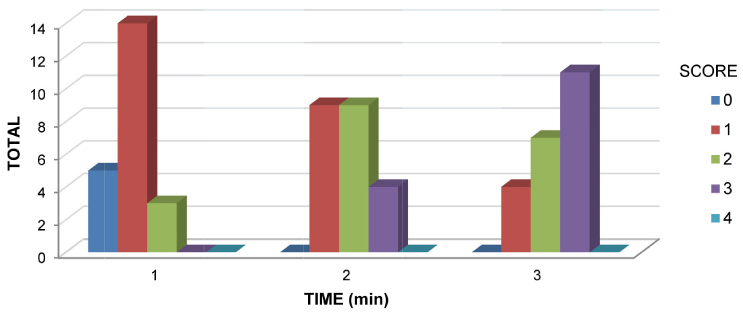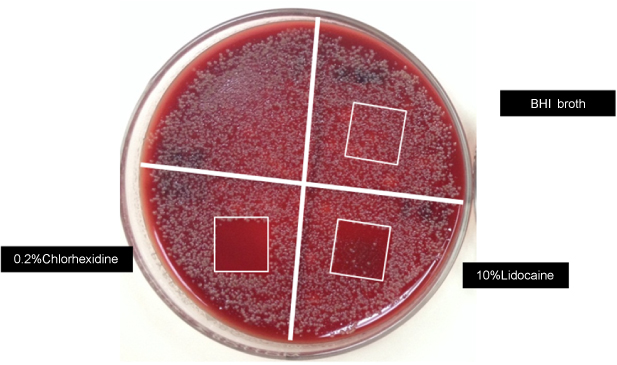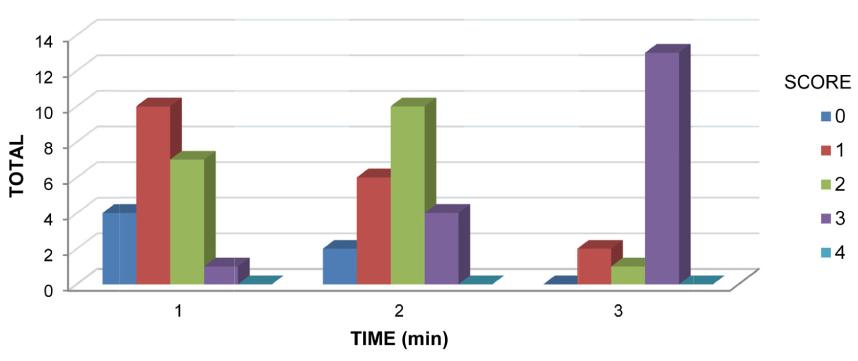J Dent Anesth Pain Med.
2016 Mar;16(1):17-24. 10.17245/jdapm.2016.16.1.17.
Antimicrobial effect of topical local anesthetic spray on oral microflora
- Affiliations
-
- 1Department of Oral Microbiology Faculty of Dentistry Mahidol University, Bangkok, Thailand.
- 2Department Oral & Maxillofacial Surgery, Faculty of Dentistry Mahidol University, Bangkok, Thailand. natthamet.won@mahidol.ac.th
- KMID: 2308761
- DOI: http://doi.org/10.17245/jdapm.2016.16.1.17
Abstract
- BACKGROUND
To evaluate the antimicrobial activity of lidocaine (LD) topical anesthetic spray against oral microflora.
METHODS
Antimicrobial effects of 10% LD spray were assessed against six bacterial cultures obtained from volunteers: Escherichia coli, Enterococcus faecalis, Staphylococcus aureus, Streptococcus salivarius, Streptococcus pyogenes, and Streptococcus sanguinis. The filter papers contained 50-µl LD, brain heart infusion (BHI) broth, or 0.2% chlorhexidine. Papers were placed on the cultured blood plates for 1-3 min. After the papers were removed, plates were incubated for 24 h. Bacterial growth on the contact areas was recorded as the antimicrobial score. The split mouth technique was use in for sample collection in clinical study. Filter papers soaked with either BHI broth or LD were placed on the right or left buccal mucosa for 1 min, and replaced with other papers to imprint biofilms onto the contact areas. Papers were placed on blood plates, incubated for 24 h, and antimicrobial scores were determined. Experiments were conducted for 2- and 3-min exposure times with a 1-day washout period.
RESULTS
LD exhibited bactericidal effects against E. coli, S. sanguinis, and S. salivarius within 1 min but displayed no effect against S. aureus, E. faecalis, and S. pyogenes. The antimicrobial effect of LD on oral microflora depended upon exposure time, similar to the results obtained from the clinical study (P < 0.05). LD showed 60-95% biofilm reduction on buccal mucosa.
CONCLUSIONS
Antimicrobial activity of 10% LD topical anesthetic spray was increased by exposure time. The 3 min application reduced oral microflora in the buccal mucosa.
MeSH Terms
Figure
Reference
-
1. Erlich H. Bacteriologic studies and effects of anesthetic solutions on bronchial secretions during bronchoscopy. Am Rev Respir Dis. 1961; 84:414–421.2. Kleinfeld J, Ellis PP. Inhibition of microorganisms by topical anaesthetics. Appl Microbiol. 1967; 15:1296–1298.3. Kleinfeld J, Ellis PP. Effects of topical anesthetics on growth of microorganisms. Arch Ophthalmol. 1966; 76:712–715.
Article4. Sculley PD, Dunley RE. Antimicrobial activity of a lidocaine preparation. Anesth Prog. 1980; 27:21–23.
Article5. Morrow ME, Berry CW. Antimicrobial properties of topical anesthetic liquids containing lidocaine or benzocaine. Anesth Prog. 1988; 35:9–15.
Article6. Feldman JM, Chapin-Robertson K, Turner J. Do agents for epidural analgesia have antimicrobial properties? Reg Anesth. 1994; 19:43–47.
Article7. Berg JO, Mössner BK, Skov MN, Lauridsen J, Gottrup F, Kolmos HJ. Antibacterial properties of EMLA® and lidocaine in wound tissue biopsies for cultuting. Wound Repair Regen. 2006; 14:581–585.
Article8. Pelz K, Wiedmann-Al-Ahmad M, Bogdan C, Otten JE. Analysis of the antimicrobial activity of local anaesthetics used for dental analgesia. J Med Microbiol. 2008; 57:88–94.
Article9. Winther JE, Praphailong L. Antimicrobial effect of anesthetic sprays. Acta Odont Scand. 1969; 27:205–218.
Article10. Mullin GS, Rubinfeld RS. The antibacterial activity of topical anesthetics. Cornea. 1997; 16:662–665.
Article11. Aydin ON, Eyigor M, Aydin N. Antimicrobial activity of ropivacaine and other local anesthetics. Eur J Anaesthesiol. 2001; 18:687–694.
Article12. Kerenyi M, Batai MR, Juhasz V, Batai I. Lidocaine/prilocaine ointment (EMLA) has an antibacterial effect in vitro. J Hosp Infect. 2004; 56:75–76.
Article13. Sedef Gocmen J, Buyukkocak U, Caglayan O. In vitro antibacterial effects of topical local anesthetics. J Dermatolog Treat. 2008; 19:351–353.
Article14. Robert GJ, Simmons NB, Longhurst P, Hewitt PB. Bacteraemia following local anaesthetic injections in children. Br Dent J. 1998; 185:295–298.
Article15. Parr AM, Zoutman DE, Davidson JS. Antimicrobial activity of lidicaine against bacteria associated with nosocomial wound infection. Ann Plast Surg. 1999; 43:239–245.
Article16. Streitfeld MM, Zinner DD. Microbiological hazards of local dental anesthesia. Pilot study of involuntary aspiration of bacteria into hyperdermic needles and anesthetic cartridges after injection. J Am Dent Assoc. 1958; 57:657–664.
Article17. Barbosa M, Carmona IT, Amaral B, Limeres J, Álvarez M, Cerqueira C, et al. General anesthesia increases the risk of bacteremia following dental extractions. Oral Surg Oral Med Oral Pathol Oral Radiol Endod. 2010; 110:706–712.18. Baltch AL, Pressman HL, Hammer MC, Sutphen NC, Smith RP, Shayegani M. Bacteremia following dental extractions in patients with and without penicillin prophylaxis. Am J Med Sci. 1982; 283:129–140.19. Baltch AL, Schaffer C, Hammer MC, Sutphen NC, Smith RP, Shayegani M, et al. Bacteremia following dental cleaning in patients with and without penicillin prophylaxis. Am Heart J. 1982; 104:1335–1339.
Article20. Schmidt RM, Rosenkranz HS. Antimicrobial activity of local anesthetic: lidocaine and procaine. J Infect Dis. 1970; 121:597–607.
Article21. Silva MT, Sousa JC, PolÒonia JJ, Macedo PM. Effects of local anesthetics on bacterial cells. J Bacteriol. 1979; 137:461–468.22. Fazly Bazaz BS, Salt WG. Local anesthetics as antimicrobial agents: structure-action considerations. Microbios. 1983; 37:45–64.
- Full Text Links
- Actions
-
Cited
- CITED
-
- Close
- Share
- Similar articles
-
- The efficiency of topical anesthetics as antimicrobial agents: A review of use in dentistry
- A comparative evaluation of peppermint oil and lignocaine spray as topical anesthetic agents prior to local anesthesia in children: a randomized clinical trial
- The Local Anesthetic Effect of 10% Lidocaine Spray on the Larynx
- Investigation of Efficacy of Lidocaine Spray for Sedated Esophagogastroduodenoscopy in Children
- DentalVibe reduces pain during the administration of local anesthetic injection in comparison to 2% lignocaine gel: results from a clinical study





